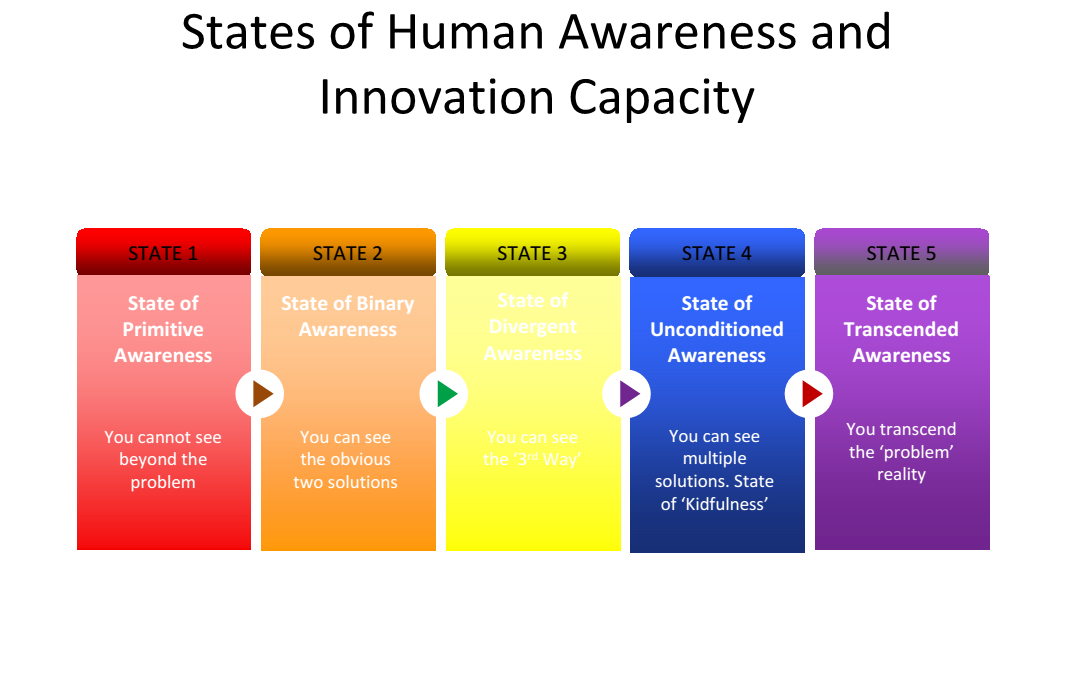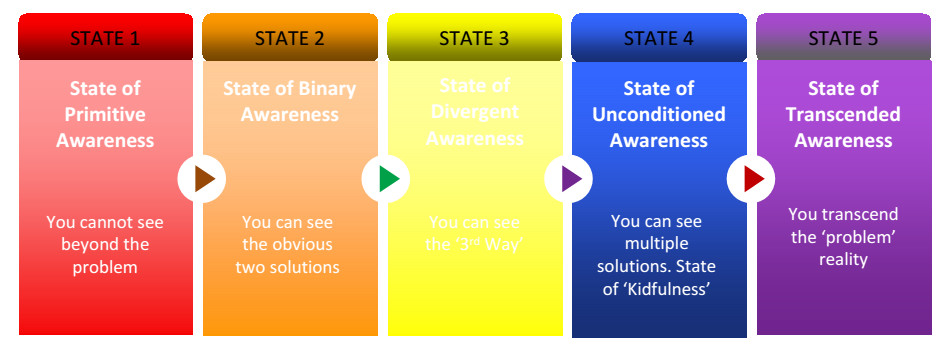(credit for this work/model goes to Mark Vandeneijnde, John H Van Drie and numerous scientific and mystical experts who have contributed)
Innovation has become one of the biggest priorities for organizations today. According to a recent study by PWC, the most innovative companies are set to grow at twice the pace of the global average over the next five years (and three times faster than the least innovative ones).
However, it is startling to find that the current efforts – which include significant investments in innovation systems and process (for example, knowledge databases, market research and Design Thinking) – are yielding lower rates of return. According to a recent Deloitte study of the return on innovation for the Pharmaceutical industry, companies have seen a significant decline in sales (-50%) despite increases in R&D investment (+33%) between 2010 and 2015.
* * * * *
Since the beginning of the Industrial Age, innovation has been important to businesses. But innovation first became the big obsession it is today in the early 90s simply because other improvement efforts like vertical integration and quality improvement practices had all peaked out.
When the innovation craze began, the biggest focus for innovation managers was on innovation-enhancing SYSTEMS. Systems speeded up information flow, accelerated the diffusion of knowledge across boundaries, enhanced communication between the researchers and derived insights from previous research. Systems connected labs and sources of science with each other. Organizations became connected to universities, research databases and global libraries.
The introduction of systems created quite a rush of innovations in the early 90s.
When that wave started to die down towards the late nineties, the next wave of innovations began with the introduction of a rush of innovation-enhancing PROCESSES. Suddenly, there were numerous releases of innovation methodologies, and I would come across innovation consultants who could be called upon to facilitate innovation teams through innovation processes.
Processes like brainstorming sessions brought together a bunch of stakeholders, wildly brainstorming using post-its, clustering them and evaluating these ideas against a select set of criteria.
The rapid prototyping process involves researchers responding swiftly when somebody has an idea or a customer says, “I very much like to have this”. Then they would instantly go into the lab and start quickly creating a very simple prototype.
Processes like Design Thinking and AGILE are very current and popular methodologies where inventors are made to step into the reality of the user, reenact the experience of the user, and use empathy and ideation to become part of the environment where a product is used.
When we listen into the industry, we hear that in spite of all these investment, innovation is drying out simply because process thinking is peaking. Companies are now desperately searching for the next wave of thinking for accelerating growth.
So what is the next wave of thinking that will accelerate innovation?
We at BEING AT FULL POTENTIALrecognize that the next wave of innovations is going to be unleashed by pulling the human lever. It is going to come from harnessing the human states – not systems and processes – by moving people into heightened states of awareness where they become infinitely creative.
* * * * *
“No problem can be solved from the same level of consciousness that created it.” Albert Einstein
We have identified five human states of awareness where we are creative in different ways.
In the first state, a state that we call the State of Primitive Awareness, our mental faculties are so blocked that we cannot see beyond the problem. Consumed by fear or anxiety we are unable to see solutions.
People who are in this state turn into ‘deer in the headlights’ when they are confronted by problems in life.
You present a problem to a person who is in this state, and he just freezes. “Oh my God, at the end of this month I am unable to pay my bills. I don’t know what I am going to do!”
When they are in such a fear-driven or anxious state, they cannot see beyond the problem. They do not see any solution to a problem. No amount of reasoning or rational conversation is helpful when someone is in this state.
When people are raised to a slightly higher state, a more expanded inner state, they can see two solutions to every problem. We call this state the State of Binary Awareness.
In this higher state of awareness, people see two solutions to every problem; Yes or No, Do or Die, Black or White, Left or Right, Stay or Leave, Democrat or Republican.
Suppose you know someone who is having problems in her relationship. If you ask her what solutions she sees, she will come up with two options; one is that she will simply continue with her relationship as it is, or the second solution that she would see is to say good bye to that relationship.
In this state of awareness, innovation is binary. Most people I meet are in this state of awareness where they see two solutions to every problem.
There is a higher state, a third level of awareness. This is the first ‘breakthrough’ state where we step out of the binary state while still using the limited human mind. In this state, suddenly you can see beyond the typical two solutions that most others can see to any problem. You are able to step into the ‘space in between’ and see a third way to typical problems. It is not anymore…”yes I will put up with this unhappy relationship or I will get out this relationship”. You see the possibility to reinvent the relationship, or improve the communication or some other third alternative to the problem.
We like to call this third state of awareness the State of Divergent Awareness. This is also the first state where goodness becomes a motive of innovation. In this state, you feel inclined towards innovations that go beyond your personal benefits to embrace the collective good.
Many advanced thinkers and researchers experienced this state of awareness. Leaders like Gandhi and Mandela who reshaped nations and societies were able to access such third ways.
A great example of the creativity from this state of awareness is the famous story of how Dr. Martin Luther King Jr. found his revolutionary path that changed the course of racial division in the USA. As a young man suffering the indignity of racial division, Dr. King was presented with the standard two options that all other young black men were presented with; continue to remain subjugated or retaliate violently. But he found a third way; embrace the revolutionary path of non-violence and forgiveness.
When people step into an even heightened state of awareness that we call the State of Unconditioned Awareness, they will see multiple solutions to any given problem, sometimes even infinite solutions. We also call this state of awareness the ‘kidfulness’ state.
An innovation consultant once told me about an experiment involving 6 adults and 6 kids. Both groups were given a paper clip each and were asked to identify a bunch of uses of a paperclip. The adults came up with 15 uses for a paper clip. Guess how many uses the kids came up with?
Within a matter of minutes, the kids came up with 75 uses for a paper clip!
The kids’ minds being unconditioned can go in infinite directions. Because of the inner state in which kids are often in, they see space everywhere. In that expansive state, they can access infinite solutions to any problem.
Kids are immensely creative because of their unconditioned state. That is what we call ‘Kidfulness’; a state where our mind goes in infinite degrees.
When it comes to creativity, there is an ever higher state; an infinite, non-local state of awareness. This is the transcended state of awareness associated with sages. In this state, the problem disappears. For sages, adversities are just part of evolution. We like to call this state the State of Transcended Awareness.
When you present a ‘problem’ to people who are in this state of awareness, they do not see it is as a problem. You present to them global warming and climate change as problems and they are able to remain disentangled. As a result they are not in a ‘solution’ mindset, which is a reactive state. Instead, people in the State of Transcended Awareness are in a creative state. Their awareness is not localized to a problem, their awareness exists beyond problems.
In the midst of crisis or catastrophe, sages are able to see a new reality into which we are growing into. They see a current state of perfection and recognize that this is the place where we are meant to be today in order to grow into the next stage of evolution and growth. That state is really the State of Transcended Awareness.


